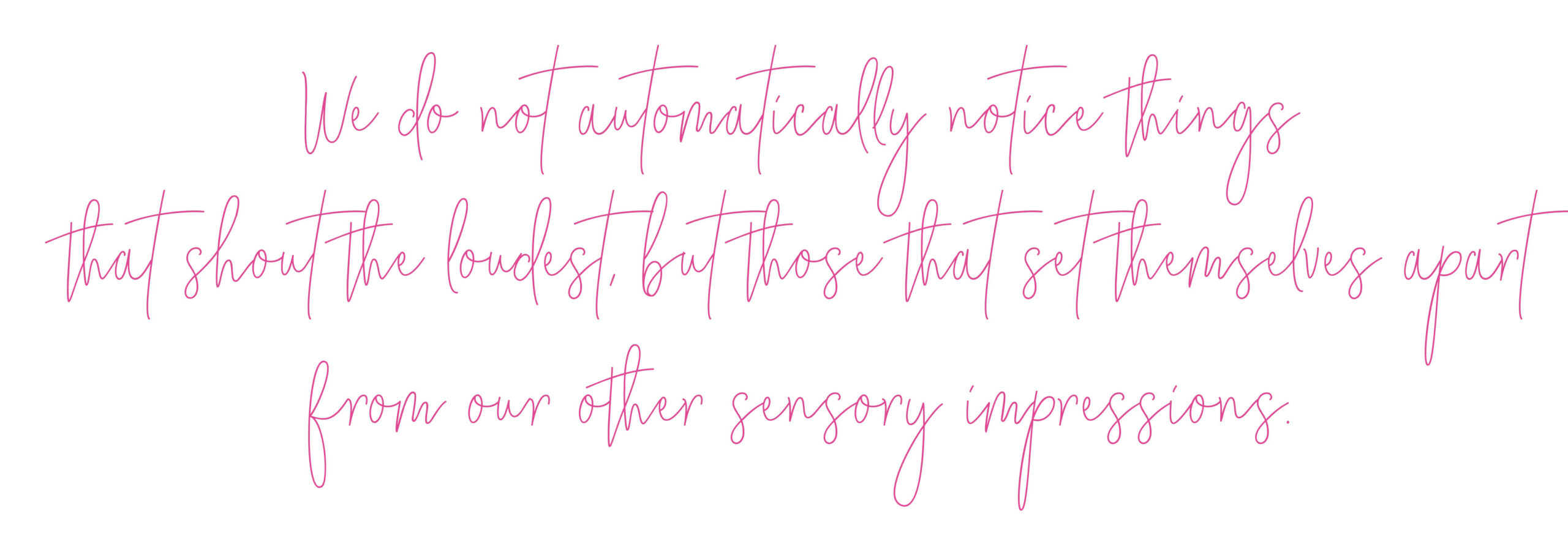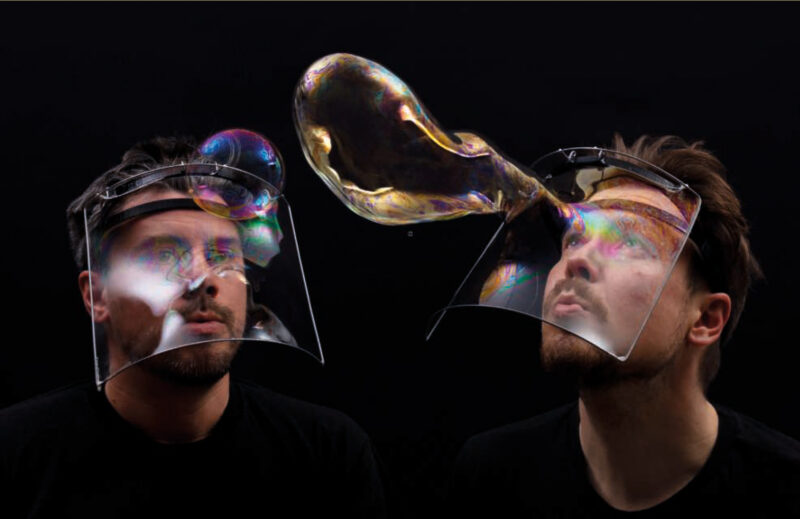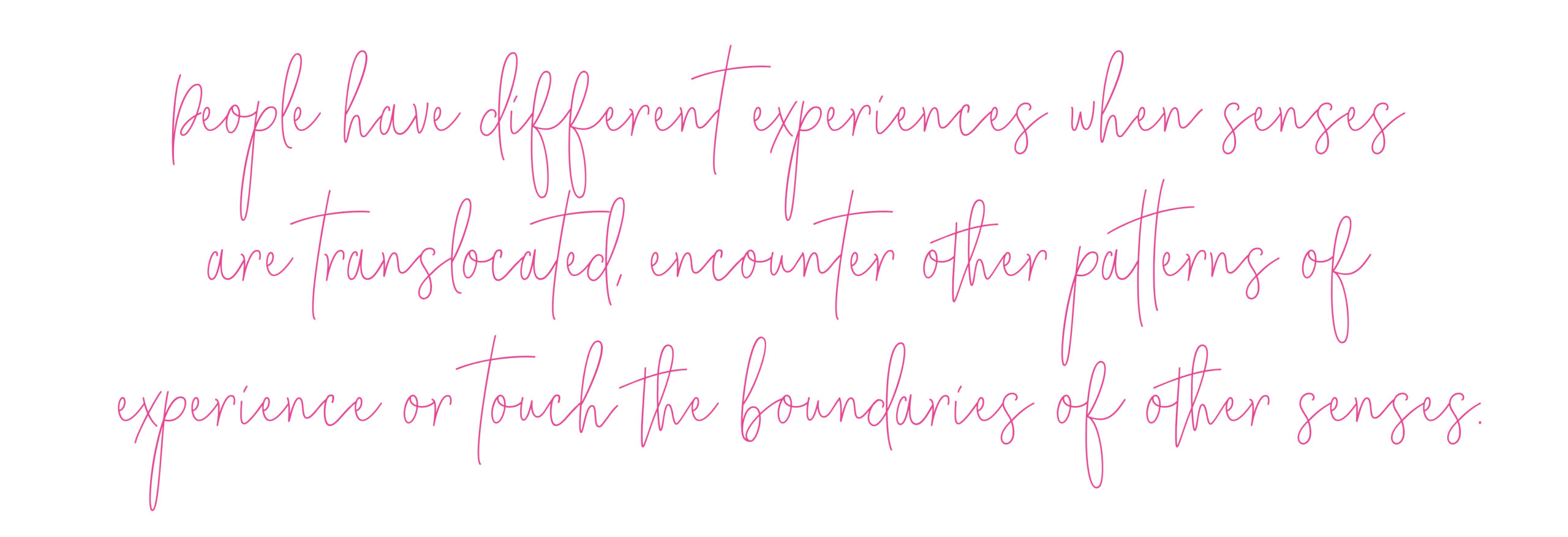Creating things relevant to our senses
Vizona meets Aerosoap (Communication design), Niklas Reiners (Light Application Manager) & Prof. Dr. Gunnar Mau (Consumer psychologist)
Human sensory perception is highly diverse, well researched, and yet still full of secrets. Could we maybe fill some gaps in the stationary retail landscape by finding new ways to address the senses? For a discussion as diverting and stimulating as this, we have chosen three different perspectives:
Consumer psychologist Gunnar Mau, lighting planner Niklas Reiners and designer duo aerosoap discuss the latest findings of multisensory research, the (non-)sense of lighting standards and ideas for sensory-oriented retail from Nice to Las Vegas.
You all deal with sensory perceptions from a wide variety of perspectives. So which sense is the most important for us humans?
NR According to the scientists, sight dominates all the other senses — with a degree of influence of more than 80 percent. But there are so many situations in which various senses confront one another! An unpleasant smell, for example, can thwart a calm and appealing visual mood. Far more important than individual
senses is our own data centre that collates and processes all these stimuli.
GM I would agree with that. Sight is our most important and far-reaching sense, the one we use from our earliest days and very quickly to collect the most information. What actually guides us in our everyday lives, though, is multi-sensory perception. You notice that as soon as your senses no longer interact as
expected. Like when you lick an ice-cream that clearly looks like chocolate but then tastes of cherry.
AE One reason that sight is in the foreground is because it is the best-trained of our senses. And that in turn has to do with the media around us. We do not watch TV with our noses, we use our eyes to consume information all day long.
At first glance, your projects seem to foreground visual effects.
AE That is right. But we often communicate in spaces, and that always involves far more. If we work with fire, for example, we can smell the wood and smoke and hear the crackling. And the warmth given off by the fire stimulates the sense of touch. All these aspects need to interact if the experience is to be really genuine and tangible.
How much do we know about the influence senses have on our psyche, on our decisions?
GM Our sensory impressions have an incredible impact on us, but you cannot just press one button and can observe the same effect in everyone. It is not as simple as that. After all, upon reaching our brain, our perceptions encounter prior experiences, motives and ideas, expectations and hopes. Based on all that,
we construct a subjective perception — or assessment — of reality. If we take smell as an example: For researchers, it is very difficult to find an odour that pretty much everyone experiences as pleasant. Some odours gain high rates of approval. But then comes along a trial participant who says the sample reminds him
of his ex-girlfriend’s perfume. None of that has to take place on a conscious level. So we have to look into how sensory perceptions latch on to our individual experience.

We are talking about the five traditional senses, right?
GM Those are the ones that provide us with the most information. But then there is the question of how we experience temperature, for example. If I come in from the cold, a shop may seem like a feel-good oasis of warmth. Or not: We observed the routes customers take at grocery retailers when they are close to frozen goods. We noticed people sometimes taking a step backwards, actually recoiling. That surprised us. Nobody walks backwards, we always go forwards. So what happened? It was just unbelievably cold, especially in aesthetic terms! And that sent consumers’ subjective temperature plummeting.
So what signposts are there for store designers and retail strategists? Does research offer any specific tips?
GM Several studies, some of which large scale, address this question and offer numerous useful findings. To give one example: A study observed the flow of visitors to a beverages retailer. The store was full of attention-grabbing installations, displays and digital stelas, the full works. What visitors actually looked at, though, were not things in motion, because everything was in motion, but rather an analogue display with a relatively calm and dark design. And the finding is this: We can only buy what we notice. And we do not automatically notice things that shout the loudest, but those that set themselves apart from our other sensory impressions.
AE The quiet things are often the most effective, you are right there. We noticed that with ‘Bubble Wall’, our project for the Adobe Creativity Conference in Las Vegas. We knew that everything in this city is gaudier, louder, bigger, brighter. The only way to have an impact was to be quiet. So our stand at the fair was totally black and highly reduced, and that produced the desired effect. People paused at the stand because it was a point of calm. Then they wanted to know how the air bubbles emerged from the black wall in the form of an Adobe logo.
GM Exactly, something stands out and that attracts interest. Of course, it means you are also conveying the messages: Black counts as elegant and “premium” and is less flippant. It is a colour that invites people to enjoy the moment.
NR I just thought about how I was once in the historic centre of Nice and bought a rolling pin made of olive wood, presumably at twice the normal price. The store was small and actually too dark. But that also made it very quiet and me aware of my other senses. At the counter, the rolling pin was gently packed in tissue
paper with all the attendant rustling — and I perceived that as real craft, as a personal package just for me. The feelings I experienced came close to ASMR*. And it was the deliberately subdued lighting which made these perceptions possible. Incidentally, that approach is nothing new. It was a key design focus in
nearly all cultures in centuries past as well.
* Autonomous Sensory Meridian Response designates a tingly feeling experienced as pleasant and radiating across the whole body It is triggered by specific acoustic and optic stimuli. In 2021/22, it was the third-most frequent search term on YouTube.
And is retail light design also governed by standards discovered over the years? What rules would you see as “untouchable”?
NR There are facts that appear to be set in stone and also backed up by research. But much still remains to be done in terms of our focus. I will give you one example: One unwritten rule is that 500 Lux illumination is required in checkout areas. That is certainly true in the sense that otherwise you cannot see properly. However, the number does not tell you anything about how the light output is created, what effect it has and what quality and colour the light has. My eyes are permanently adjusting. You have to account for that and can actually factor it deliberately into your plans.
Can you give us an example?
NR We were commissioned to illuminate an adjoining room for exotic collectors’ plants at a garden centre. For that, we deliberately opted for bright pink light. Visitors to the room found that their eyes adapted within half a minute. After that, they perceived the room as delicate pink, rather than bright pink. And the next
surprise awaited them when they left the room. The whole environment suddenly appears in a green tone — a phenomenon that absolutely matched the concept.
GM We should define recommendations or criteria based on the psyche rather than formulating them as hard facts. Particularly in retail, we are prepared to look far more closely at things if the environment triggers the right feelings. And we are also willing to spend more — or at least the statistical likelihood is higher — even if we could purchase the same product for less just fifty meters away. And that even knowingly. We are prepared to pay for the feeling of wellbeing.

Chance and bewilderment play a huge role.
AEROSOAP
Logos that explode, brand items that hover, exhibition stands that melt into thin air: Communication designers Thomas Wirtz and Frédéric Wiegand first met at Düsseldorf University. Together, they founded aerosoap, a creative lab to implement projects “at the intersection of art, design and science”. They share and multiply the insights gained from their experimental work in their teaching, research and workshops.
And what is that feeling of wellbeing from a scientific perspective?
GM Feelings are subjective of course, but for most people it involves a state in which they drop their guard and are able to relax. It is a state which tells me: Everything is alright. I become less critical and am also prepared to place my trust in the retailer.
That sounds like deep calm. But are people not always on the lookout for something new and exciting?
AE The most important aspect of our work is to create a sense of slight bewilderment. We do that by decontextualising materials. What happens if I make something hover that otherwise never hovers or if I allow a script to burn? People have different experiences when senses are translocated, encounter other patterns of experience or touch the boundaries of other senses.
GM It is give and take. Nearly all people have an exploratory motive, they wish to extend their sphere of influence, as psychologists say. To get to know things that they do not know yet. That is why novelties impact on us. The problem is that we do not really like new things! We like things we recognise. A music producer once told me that, for a hit, you need eighty percent well-known stuff for the feel-good factor and then you add twenty percent new material so that it is not boring. Mild divergences from a “prototype” attract our attention and ensure we still approve of them.
How do you tread this fine line at aerosoap? Are people also open to your spatial installations when you invite them to take charge of things themselves?
AE A certain playful instinct has always formed part of the mix in our work. But inhibitions vary very widely from region to region. We were forewarned about that when we prepared the project for Las Vegas. The client told us: “Don’t forget we have none of those German reservations here. Americans are far less inhibited if there is something to try out!” And that was really noticeable.
Do your customers also sometimes need a little encouragement to accept your ideas?
AE The first thing we do is bolster the client’s courage and maintain it through all phases of the project. That said, people come to us specifically to try out something unheard of. That is why, during the first experimental phase, we deliberately play with the power of chance to gain new insights or discover new paths.
NR Do you also have difficulties visualising the effects for the client in advance? When it comes to planning lighting design, the quality of the design schemes is sadly often decided on the screen. Even 3D programmes fail to capture major aspects of the actual dimensions and lighting impressions. That is why at ansorg we have a lighting room where we can recreate spatial situations almost in real life conditions and then demonstrate these to clients.
AE Yes, it is a real challenge. Often our ideas only take shape in the laboratory, when we are actually thinking about materials, and the chemical processes also cannot be visualised. That is why we only provide a foretaste with actual renderings in exceptional cases. Other than that, we work with prototypes. We put these through the test stages and film the whole process to show whether an idea actually works and what it looks like. Further down the line, we test it all in real conditions, preferably on site at the actual location.
I always need something to fascinate me.
NIKLAS REINERS
What lighting applications fit the envisaged customer journey? That is the question Niklas Reiners addresses in his work as a light application manager at a prestigious manufacturer of lighting solutions and lights for retailers. He is surprised by how often retailers fail to set individual standards for this important medium. He already investigated human light perception during his studies. Today, he himself teaches students in the Retail Design course at Düsseldorf University.

You experiment with chemicals, objects and consistencies that are highly unusual. Are there any materials where you stop to ask yourself whether anyone in architecture or brand whether anyone in architecture or brand?
AE Slime.
GM Slime?
AE Yes, we did a lot of experiments with electrically conductive slime and used it as an interface to modulate light and sound. We also built a gateway that reconstructs itself once you have passed through. Our formula offers amazing viscoelasticity, the slime fluctuates between solid and liquid state. And if you see
what you can do with the material, that initial yucky impression fades away and people seek contact with it. We really do believe that this material has potential.
GM Of course, the word “slime” does not help, it does not sound attractive. And that is because of our previous experience. If you put that to one side and just listen to you two, then the material gains a quite different fascination.
We could call it ‘electric cream’ …
GM That is a good example for how words can emulate and influence sensory perceptions in the mind.
But that moment of surprise is still there of course when you first encounter the forms in the space. And that brings us to the question: Can we draw on that sense of bewilderment in the customer journey — and if so, where?
GM I definitely need moments like that! Retail and shopping are very much habits. Whether in town or in the shop itself: I tend to take the same route, visit the same shelves, always do the same thing. That is because it is easier in cognitive terms. And that of course makes things tougher for a brand aiming to be perceived
as new. So if I am a retailer trying to encourage people not to act like they always act, that is when I need the slime!
NR Talking about the right place and time: When I enter a store, I often suffer immediate sensory overload. If I walk into a large department store during a campaign, all my senses are suddenly and randomly lamed. I am confronted with a new acoustic backdrop, my olfactory system jumps into action, suddenly everything smells different, my tactile senses are surprised by the airlock. The floor is different from the paving stones outside and the interior, already bright, is often provided with extra bright illumination. This concept may well make sense from a distance, but when I enter the store it is exactly what I am not looking for.
Viewed from a social perspective, I feel like I am on a stage. And yet it is a new setting that I am entering and I first need to find my bearings. For example, I want to know if I am welcome.
GM That problem cannot be overstated. You have to understand that the act of purchasing is a journey through a store. And people who enter the store are already highly activated upon arrival. So our aim should not be to endlessly raise their activation levels. If we do, the famous Yerkes-Dodson law will kick in: Any need to activate is soon followed by a decline in performance …

So you grab their attention then let them relax?
GM Exactly. At some point customers are “zonked” and just want to get their shopping done. So the goal at the outset is to attract their attention to specific products or messages. During my journey, my level of activation begins to decline. That is why many retailers think they have to turn every shelf into an experience so as to maintain a high level of activation. But that just triggers a downward spiral: You always have to step up a gear and the point comes where customers are exhausted. Research shows you should mix tension and relaxation. That also applies to design.
Sensory-oriented retail design can take us in very different directions. Some players are currently taking the “hyperphysical” approach, coating their flagship stores in blue from floor to ceiling or decorating them with pink fur to create a highly artificial aesthetic. Others have heard the call of nature and work with manufacturers whose material innovations bring the natural world indoors. When do we sense something as being natural — and is it worth drawing on this in sales spaces?
NR Here too, our non-visual senses are ever more relevant. On the Organoid surfaces, for example, you can smell the hay and the pressed flowers. If I walk across real floorboards, I feel the elasticity of the wood. I also notice if a shelf is merely coated with natural materials or actually made of the real thing. It just has a different aura for our senses. But you can also start with the lighting. Lights with small LED points, for example, which are pretty widespread these days, are completely unnatural. They produce very hard light while also creating unnatural micro-shadows. That is a situation where I cannot trust my surroundings in any authentic natural way. What is more natural is to arrange the light as point-based light sources that — like sunlight — give off light in a harmonically radiating way. Or we can create routes, like arcades, that gently merge into each another. Or you can deliberately integrate constantly evolving daylight. That can create spectacular effects, particularly in the morning sunshine.
That is a range of options that surely has a certain price tag …
NR You just need greater awareness in the conceptual planning stage. And then you can even make savings when it comes to purchasing and maintaining the components. After all, pointbased light is more accentuated, I focus the light where I really need it and therefore use less electricity overall. And that is without even mentioning the sustainability of flexibly adaptable solutions. With spots, I can also apply more kinetic energy to the surface if I use them creatively …
Light in motion?
NR Yes, I need that to create an appealing sense of naturalness. If possible, I like to focus spotlights directly over a plant or I trace light and current bars right through the greenery to obtain the projection of natural shadows onto the store space. As soon as there is a draught, the shadows begin to move and I gain a
kinetic experience on top.
GM One question I ask myself is why stores do so little to integrate their surroundings? For decades, it was all about making everything static and sealing off stores from the outside world so people would only focus on the products. But now we can order everything online — and it is scary to see how rarely stores give us a good reason to look by. What counts is the overall experience, also how I feel when I see the staff and notice whether my hospitality expectations have been satisfied.

Retailers are not making enough of
the advantages they have over online.
PROF. DR. GUNNAR MAU
How do our senses influence our purchase decisions? Business psychologist Gunnar Mau has dedicated all stations of his academic career to examining this and related questions. He investigated the role emotions play in online purchases for his doctorate and is the co-founder of a market research company. As professor of applied psychology at the German University of Health and Sport in Berlin, his research interests include ‘Multi-sensory Approaches in Stationary Retail’. In 2021, he co-edited a topical publication with the same title.
In online shops, customers are limited to optical and auditory perceptions. For many people, that is still more convenient than leaving the house. Might we be overestimating the value of the multisensory experience?
GM That is a legitimate question. I cannot portray everything online. I have to do without sensory stimuli and thus also loose some information. But it is the retailer who decides whether that is useful information. The odourless nature of online is often even advantageous. So one question they have to ask is this: How can the sense of smell be put to strategic use?
NR I always need something to fascinate me, something that really speaks to me. No potpourri of stimuli just for the effect. I told you about the rolling pin in Nice. That created a tingle, there was a certain tension and I wanted to stay focused. And now I have a product at home that connects me to that place and its appeal every time I use it. And that is why I use it, even though I have another rolling pin that actually works better.
GM You can also see how important sensory variety is if you look at the efforts digital retailers make to compensate for their sensory poverty or reduction with words, images and sounds. That can all work really well when people are prepared to play along, but it is far from the real thing. Studies show that the smaller the distance to a product, the stronger my emotional response is and the greater the likelihood I will actually buy it. So stationary retailers need to think about how they can promote multisensory perceptions. They need to make more of the advantages they have over online retailers.

Looking at it the other way round, what can we learn from the digital world when we design a shopping experience, particularly in extending the technical dimension?
AE We have to make a distinction between digitalisation and digitalism. And digitalism is something we can put to very good use in stationary retail. Just one example: We can use remote control to activate a performance, one that maybe brings us into contact with other customers. It has to move us organically to what we wish to experience.
GM These days, stores often welcome their visitors with digital stelas — as if they have to prove that they too can do “digital”. But it is not about showcasing technology. We have to take customers on a journey and latch on to their own experiences. The best way to do that is when they do not even notice that they are moving from analogue to digital.
AE In our work, we are often limited by what is actually plannable in a given space. That is what makes film so tempting. Basically, far more is possible, also during the experimental stage, particularly because the viewer on location is one step removed from the material. That said, the loudest explosion on a screen
often attracts less attention than when a small green candle is lit somewhere in a dark corner of the room. The recipient can approach a genuine event in the space, actually experience it and turn it into something meaningful.
GM A real candle transmits so much more sensory information. I can hear the crackle, smell the aroma, feel the warmth. That centres me. It becomes relevant to me — and relevance is what it is all about.